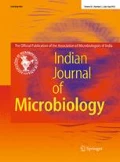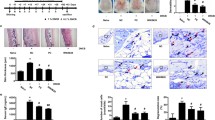Abstract
Atopic dermatitis (AD) is the most common chronic inflammatory skin disease and is driven by strong type 2 immune responses. Lactobacillus helveticus NS8 (NS8), a probiotic strain isolated from Mongolian koumiss, has anti-inflammatory activities. Here, we evaluated the therapeutic potential of NS8 on AD-like skin lesions by using SKH-1 hairless mice that underwent three cycles of epicutaneous sensitization (EC) with ovalbumin (OVA). NS8 (5 × 108 CFU/day) was orally administered to mice from 2 weeks before the first sensitization until the end of the study. NS8 attenuated the symptoms and pathological changes in the skin of AD mice. For example, NS8 reduced epidermal and dermal thickening and significantly restrained the infiltration of mast cells, eosinophils, and CD4+ T cells into the dermis. By analysing the Th1/Th2 cytokines produced in skin lesions, we found that NS8 significantly suppressed the expression of IL-4, IL-5, and IL-13 (P < 0.05), while it had no discernible effect on the expression of IFN-γ. Systemically, NS-8 reduced the total IgE and OVA-specific IgE levels in serum (P < 0.05). Our study demonstrates that oral administration of L. helveticus NS8 effectively alleviates AD severity in mice by suppressing the Th2 immune response. NS8 may be a promising candidate for prophylactic and therapeutic treatments of allergic diseases, such as AD.





Similar content being viewed by others
References
Nutten S (2015) Atopic dermatitis: global epidemiology and risk factors. Ann Nutr Metab 66:8–16. https://doi.org/10.1159/000370220
Kantor R, Silverberg JI (2017) Environmental risk factors and their role in the management of atopic dermatitis. Expert Rev Clin Immunol 13:15–26. https://doi.org/10.1080/1744666X.2016.1212660
Sokolowska M, Akdis CA (2017) Highlights in immune response, microbiome and precision medicine in allergic disease and asthma. Curr Opin Immunol 48:iv–ix. https://doi.org/10.1016/j.coi.2017.10.009
Eichenfield LF, Ahluwalia J, Waldman A, Borok J, Udkoff J, Boguniewicz M (2017) Current guidelines for the evaluation and management of atopic dermatitis: a comparison of the Joint Task Force Practice Parameter and American Academy of Dermatology guidelines. J Allergy Clin Immunol 139:S49–S57. https://doi.org/10.1016/j.jaci.2017.01.009
Lambrecht BN, Hammad H (2017) The immunology of the allergy epidemic and the hygiene hypothesis. Nat Immunol 18:1076–1083. https://doi.org/10.1038/ni.3829
Kennedy EA, Connolly J, Hourihane JO, Fallon PG, McLean WHI, Murray D, Jo JH, Segre JA, Kong HH, Irvine AD (2017) Skin microbiome before development of atopic dermatitis: early colonization with commensal staphylococci at 2 months is associated with a lower risk of atopic dermatitis at 1 year. J Allergy Clin Immunol 139:166–172. https://doi.org/10.1016/j.jaci.2016.07.029
Yadav R, Kumar V, Baweja M, Shukla P (2017) Gene editing and genetic engineering approaches for advanced probiotics: a review. Crit Rev Food Sci Nutr. https://doi.org/10.1080/10408398.2016.1274877
Dahiya DK, Renuka Puniya M, Shandilya UK, Dhewa T, Kumar N, Kumar S, Puniya AK, Shukla P (2017) Gut microbiota modulation and its relationship with obesity using prebiotic fibers and probiotics: a review. Front Microbiol 8:563. https://doi.org/10.3389/fmicb.2017.00563
Rather IA, Bajpai VK, Kumar S, Lim J, Paek WK, Park YH (2016) Probiotics and atopic dermatitis: an overview. Front Microbiol 7:507. https://doi.org/10.3389/fmicb.2016.00507
Avershina E, Cabrera Rubio R, Lundgard K, Perez Martinez G, Collado MC, Storro O, Oien T, Dotterud CK, Johnsen R, Rudi K (2017) Effect of probiotics in prevention of atopic dermatitis is dependent on the intrinsic microbiota at early infancy. J Allergy Clin Immunol 139:1399 e1398–1402 e1398. https://doi.org/10.1016/j.jaci.2016.09.056
Fiocchi A, Pawankar R, Cuello-Garcia C, Ahn K, Al-Hammadi S, Agarwal A, Beyer K, Burks W, Canonica GW, Ebisawa M, Gandhi S, Kamenwa R, Lee BW, Li H, Prescott S, Riva JJ, Rosenwasser L, Sampson H, Spigler M, Terracciano L, Vereda-Ortiz A, Waserman S, Yepes-Nunez JJ, Brozek JL, Schunemann HJ (2015) World Allergy Organization-McMaster University Guidelines for Allergic Disease Prevention (GLAD-P): probiotics. World Allergy Organ J 8:4. https://doi.org/10.1186/s40413-015-0055-2
Ozdemir O (2010) Various effects of different probiotic strains in allergic disorders: an update from laboratory and clinical data. Clin Exp Immunol 160:295–304. https://doi.org/10.1111/j.1365-2249.2010.04109.x
Rong J, Zheng H, Liu M, Hu X, Wang T, Zhang X, Jin F, Wang L (2015) Probiotic and anti-inflammatory attributes of an isolate Lactobacillus helveticus NS8 from Mongolian fermented koumiss. BMC Microbiol 15:196. https://doi.org/10.1186/s12866-015-0525-2
Kim H-J, Kim Y-J, Kang M-J, Seo J-H, Kim H-Y, Jeong SK, Lee S-H, Kim J-M, Hong S-J (2012) A novel mouse model of atopic dermatitis with epicutaneous allergen sensitization and the effect of Lactobacillus rhamnosus. Exp Dermatol 21:672–675. https://doi.org/10.1111/j.1600-0625.2012.01539.x
Taniguchi Y, Kohno K, Inoue S, Koya-Miyata S, Okamoto I, Arai N, Iwaki K, Ikeda M, Kurimoto M (2003) Oral administration of royal jelly inhibits the development of atopic dermatitis-like skin lesions in NC/Nga mice. Int Immunopharmacol 3:1313–1324. https://doi.org/10.1016/S1567-5769(03)00132-2
Czarnowicki T, Malajian D, Shemer A, Fuentes-Duculan J, Gonzalez J, Suarez-Farinas M, Krueger JG, Guttman-Yassky E (2015) Skin-homing and systemic T-cell subsets show higher activation in atopic dermatitis versus psoriasis. J Allergy Clin Immunol 136:208–211. https://doi.org/10.1016/j.jaci.2015.03.032
Yeom M, Sur BJ, Park J, Cho SG, Lee B, Kim ST, Kim KS, Lee H, Hahm DH (2015) Oral administration of Lactobacillus casei variety rhamnosus partially alleviates TMA-induced atopic dermatitis in mice through improving intestinal microbiota. J Appl Microbiol 119:560–570. https://doi.org/10.1111/jam.12844
Holowacz S, Blondeau C, Guinobert I, Guilbot A, Hidalgo S, Bisson JF (2018) Lactobacillus salivarius LA307 and Lactobacillus rhamnosus LA305 attenuate skin inflammation in mice. Benef Microbes 9:299–309. https://doi.org/10.3920/BM2017.0084
Brunner PM, Guttman-Yassky E, Leung DY (2017) The immunology of atopic dermatitis and its reversibility with broad-spectrum and targeted therapies. J Allergy Clin Immunol 139:S65–S76. https://doi.org/10.1016/j.jaci.2017.01.011
Hougee S, Vriesema AJ, Wijering SC, Knippels LM, Folkerts G, Nijkamp FP, Knol J, Garssen J (2010) Oral treatment with probiotics reduces allergic symptoms in ovalbumin-sensitized mice: a bacterial strain comparative study. Int Arch Allergy Immunol 151:107–117. https://doi.org/10.1159/000236000
Ai C, Ma N, Zhang Q, Wang G, Liu X, Tian F, Chen P, Chen W (2016) Immunomodulatory effects of different lactic acid bacteria on allergic response and its relationship with in vitro properties. PLoS ONE 11:e0164697. https://doi.org/10.1371/journal.pone.0164697
He JS, Narayanan S, Subramaniam S, Ho WQ, Lafaille JJ, Curotto de Lafaille MA (2015) Biology of IgE production: IgE cell differentiation and the memory of IgE responses. Curr Top Microbiol Immunol 388:1–19. https://doi.org/10.1007/978-3-319-13725-4_1
Liu YW, Liao TW, Chen YH, Chiang YC, Tsai YC (2014) Oral administration of heat-inactivated Lactobacillus plantarum K37 modulated airway hyper responsiveness in ovalbumin-sensitized BALB/c mice. PLoS ONE 9:e100105. https://doi.org/10.1371/journal.pone.0100105
Choi CY, Kim YH, Oh S, Lee HJ, Kim JH, Park SH, Kim HJ, Lee SJ, Chun T (2017) Anti-inflammatory potential of a heat-killed Lactobacillus strain isolated from Kimchi on house dust mite-induced atopic dermatitis in NC/Nga mice. J Appl Microbiol 123:535–543. https://doi.org/10.1111/jam.13515
Segers ME, Lebeer S (2014) Towards a better understanding of Lactobacillus rhamnosus GG–host interactions. Microb Cell Fact 13:S7. https://doi.org/10.1186/1475-2859-13-S1-S7
Blanchet-Rethore S, Bourdes V, Mercenier A, Haddar CH, Verhoeven PO, Andres P (2017) Effect of a lotion containing the heat-treated probiotic strain Lactobacillus johnsonii NCC 533 on Staphylococcus aureus colonization in atopic dermatitis. Clin Cosmet Investig Dermatol 10:249–257. https://doi.org/10.2147/CCID.S135529
Rong J, Shan C, Liu S, Zheng H, Liu C, Liu M, Jin F, Wang L (2017) Skin resistance to UVB-induced oxidative stress and hyperpigmentation by the topical use of Lactobacillus helveticus NS8-fermented milk supernatant. J Appl Microbiol 123:511–523. https://doi.org/10.1111/jam.13506
Acknowledgements
This research has been supported by Natural Science Foundation of China (Nos. 81472659 and 81101560).
Author information
Authors and Affiliations
Corresponding author
Ethics declarations
Conflict of interest
The authors declare that they have no competing interests.
Rights and permissions
About this article
Cite this article
Rong, J., Liu, S., Hu, C. et al. Oral Intake of Lactobacillus helveticus NS8 Alleviates Ovalbumin-Induced Atopic Dermatitis in SKH-1 Hairless Mice. Indian J Microbiol 58, 312–318 (2018). https://doi.org/10.1007/s12088-018-0724-2
Received:
Accepted:
Published:
Issue Date:
DOI: https://doi.org/10.1007/s12088-018-0724-2




